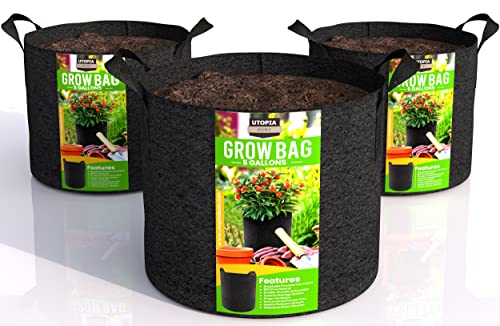The best fabric for grow bags is non-woven geotextile fabric due to its breathable and durable properties. Made from synthetic materials, this fabric allows air and water to flow through, preventing excess moisture and root rot while providing strong support for plant roots.
It is also lightweight, making it easy to move and transport. Additionally, the fabric is resistant to tearing, making it a cost-effective choice that can be reused multiple times.
Buying Guide On Best Fabric For Grow Bags
Best fabric for grow bags buying guide: 1. High quality material: look for grow bags made from durable and breathable fabric that allows air circulation and proper drainage. 2. Size and depth: consider the size and depth of the grow bags based on the plants you intend to grow.
Ensure there is enough space for root development. 3. Uv resistance: opt for fabric grow bags that are uv resistant to prevent damage from prolonged exposure to sunlight. 4. Water retention: choose grow bags with good water retention properties to avoid excessive drying out of the soil.
5. Handles: check for strong handles that make it easy to move the grow bags around, especially if you plan to relocate them frequently. 6. Reusability: select fabric grow bags that are reusable, as they offer long-term value for money and reduce waste.
7. Weed control: look for grow bags with built-in mechanisms to prevent weed growth, such as a root protection barrier or a dense fabric layer. 8. Portability: consider lightweight fabric grow bags that are easy to transport, especially if you have limited gardening space or plan to move them indoors during unfavorable weather.
9. Washable: opt for grow bags that are washable, as this helps maintain hygiene and prevents the buildup of pests or diseases. 10. Price: compare prices of various fabric grow bags, ensuring that they align with your budget while still meeting quality and durability requirements.
11. Customer reviews: read customer reviews to gain insights into the experiences of others who have used the specific fabric grow bags you are considering. 12. Customization options: if you have specific requirements, look for fabric grow bags that offer customization options such as different sizes, shapes, or colors.
13. Warranty and guarantee: check if the manufacturer offers a warranty or guarantee, which can provide peace of mind regarding the quality and performance of the grow bags. 14. Eco-friendly: consider fabric grow bags that are environmentally friendly and made from sustainable materials, reducing their impact on the planet.
15. Brand reputation: research the reputation of the brand or manufacturer to ensure they have a track record of producing high-quality fabric grow bags. 16. Compatibility: ensure that the fabric grow bags you choose are suitable for the type of plants you plan to grow, considering factors such as root structure and growth habits.
17. Temperature regulation: look for fabric grow bags that provide adequate insulation and temperature regulation to protect plants from extreme heat or cold. 18. Pest resistance: consider grow bags with features designed to deter pests, such as reinforced stitching or a fine mesh layer.
19. Thickness: opt for fabric grow bags with an appropriate thickness to withstand the weight and pressure exerted by the growing medium and roots. 20. Aesthetics: if visual appeal is important to you, select fabric grow bags that complement your garden’s overall aesthetics, as they can add a decorative element.
Remember, when choosing the best fabric for grow bags, prioritize the needs of your plants and the specific growing environment to ensure successful gardening.
Conclusion
To ensure the success of your garden, choosing the right fabric for your grow bags is crucial. After examining various options, it is clear that fabric made from a blend of polypropylene and felt is the best choice. The combination of these materials provides excellent drainage, promotes air circulation, and retains moisture without becoming waterlogged.
Additionally, the fabric is durable and resistant to tearing, ensuring that your grow bags will last for multiple seasons. Its lightweight nature also allows for easy transportation and storage. Moreover, the fabric is environmentally friendly, as it is made from recycled materials.
With its many advantages, this fabric is undoubtedly the top choice for any gardener or plant enthusiast looking to maximize their plant’s growth and yield. So, invest in this high-quality fabric and enjoy a vibrant and flourishing garden year after year.











